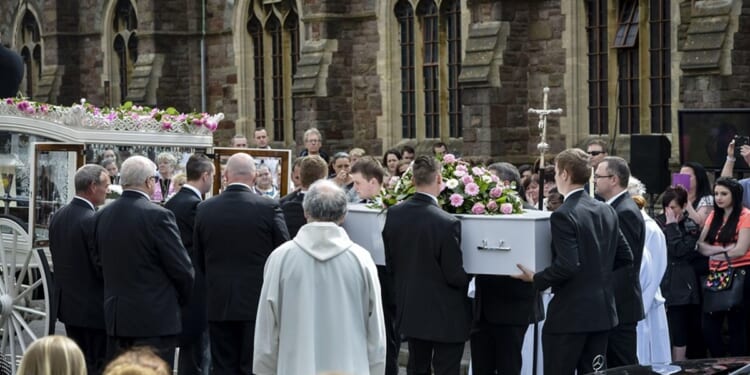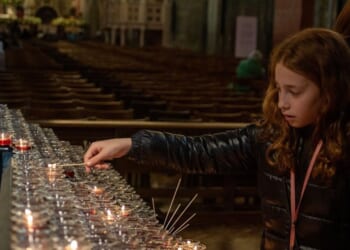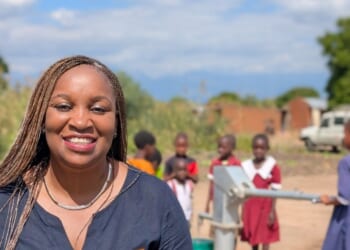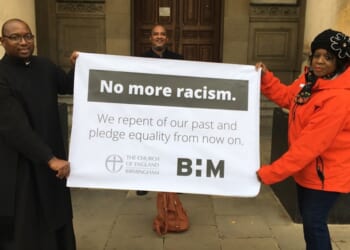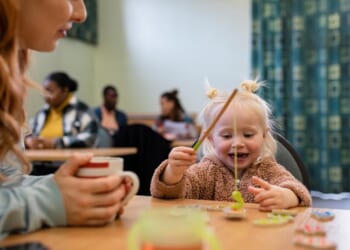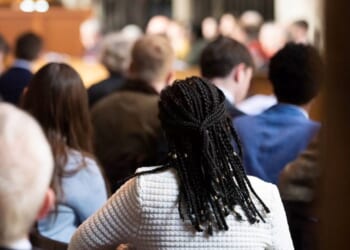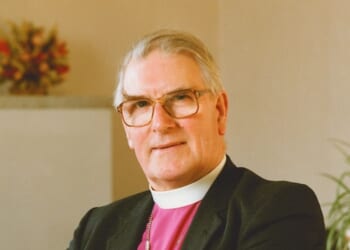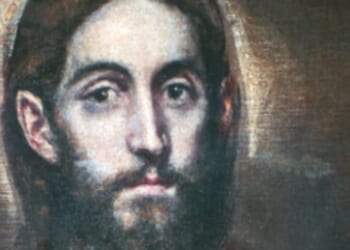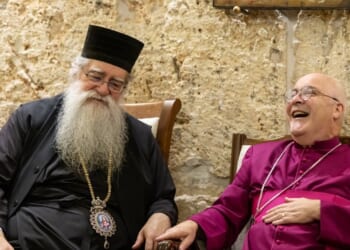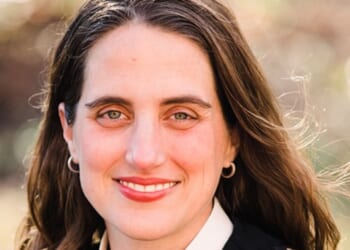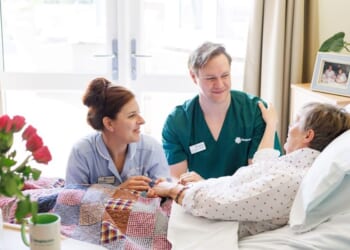FIRE, flood, and grisly murder all feature in the Old Testament, but less so in theological-college training. How should a priest or lay leader respond when disaster strikes in their parish? Church leaders who have ministered through a disaster describe what they learnt and how it affected them, so that their experiences can benefit others who find themselves in similar situations.
Will van der Hart: the 7/7 terrorist attacks
THE Revd Will van der Hart had been a priest for a week when he walked past Edgware Road Underground Station and spotted some police officers by a cordon. A 25-year-old with “no life experience of tragedy”, he says, he popped to his flat for his clerical collar and ducked under the cordon to help. “I had the feeling something serious had happened,” he recalls of that morning in July 2005. Unbeknown to him or the officers, a suicide bomber had detonated a home-made device on a Tube train in a terrorist attack; one of four, whose actions would claim 52 lives in what became known as “7/7”.
Mr van der Hart offered the hall of the church where he was curate, St Mary’s, Bryanston Square, and it soon filled with fire fighters, paramedics, and specialist police officers. He found himself listening to the stories of traumatised young police officers, and says, “I was almost absorbing the experience of it.”
Within weeks, he began suffering panic attacks that turned into depression and acute anxiety. “I had a month off work, and was put on light duties,” he says. One colleague believed that he needed exorcising; another recommended sleep; his non-Christian GP understood that he had had a breakdown. “I needed antidepressants and cognitive behavioural therapy. Then I had psychodynamic psychotherapy for about two years.” Mr van der Hart recovered, but has been diagnosed with generalised anxiety disorder (GAD).
The following year, with the psychiatrist Dr Rob Waller, he co-founded the Mind and Soul Foundation, which seeks to change attitudes to mental health in the Church, and helps clergy to join their theological training to mental-health practice.
What would he advise clergy facing a tragedy or disaster? “Prevention is far better than a cure,” he begins. “Be aware of the impact of trauma and vicarious trauma . . . the fight, flight, flop, and freeze modality, the impact on sleep, and the impact of hyper-arousal on our body.” Mr van der Hart and others have coined a term, “ministry-associated trauma”, for traumatic stories that a cleric hears.
Second, he says, Christians should not shun therapy or medication. Therapy can help someone to develop an “internal therapeutic narrative”, which would have advised him, “‘You need to go for a long walk. You need to call a friend.’”
Third, he says, develop good boundaries and a hobby. He works only “two-thirds of any day” — morning, afternoon, or evening — “which has sustained my ministry”. He restricts his news intake, especially reports from war zones, and has taken up fly fishing. It is “a total lifeline . . . incredibly mindful and absorbing”, and “where I pray best”.
Fourth, he believes that senior clergy — if not all clergy — should have monthly supervision with an independent supervisor. Doing this helped him to keep his boundaries and become aware of the impact of stress.
He would also like to see training on mental health, emotional awareness, and self-awareness made part of the curacy year.
David James and Martin Gainsborough: the murder of Becky Watts, aged 16
THE Revd David James was Vicar of St Ambrose’s, East Bristol, in February 2015, when a teenager in his parish, Becky Watts, was found murdered. Mr James had officiated at the wedding of Becky’s father and stepmother, 18 months earlier, and Becky had been a bridesmaid.
“There was shock . . . anger, frustration, and a wish to support,” he says. St Ambrose’s opened for a vigil “for two full days, which extended to three, because of demand”. On Facebook, “one post about the vigil had 60,000-plus responses, another 40,000-plus. More than 500 people came to the vigil, including some of Becky’s family.” Those wanting to help were given tasks: being on hand during the vigils, arranging flowers, and, in one instance, being a liaison with the family when they were in safe accommodation.
Mr James took two funerals: one high-profile, and another, at the request of Becky’s birth mother, in the funeral director’s chapel of rest. A colleague also celebrated a requiem shortly before the larger funeral.
In the parish near by where Becky’s remains were found dismembered, there was “shock and horror”, recalls Dr Martin Gainsborough, then Vicar of Barton Hill and St Moorfield St Matthew, and now Area Bishop of Kingston, in the diocese of Southwark. “We opened up the church, and we had a whole load of young people, probably in their teens, who just came to sit.” He also spoke to visiting media.
In November, Becky’s stepbrother, Nathan Matthews, was jailed for her murder, and his girlfriend, Shauna Hoare, for manslaughter. The night before the sentencing, Mr James opened St Ambrose’s for prayer again, “and about 30 people came.”
The Bishop of Bristol at the time, the Rt Revd Mike Hill, had one conversation with Mr James in a vestry before a confirmation service. (Bishop Hill told the Church Times that this sounded “like the kind of thing I might do”, but could not remember.)
Support that Mr James received was informal: family and friends, a clergy support group, the “media person” at the diocese, a BBC Bristol reporter, and a phone call from Canon Kathleen Rogers, who was parish priest in Machynlleth, in mid-Wales, where five-year-old April Jones was murdered in 2012.
Mr James retired shortly after the sentencing. He admits that, for a couple of years, he “wasn’t firing on all cylinders. My son had served in Afghanistan, and knew about PTSD. A sympathetic GP and an excellent counsellor were a huge help.”
What advice would they pass on? “Go with the flow,” Mr James advises. “These things take on a life of their own. Use the resources of the local church, both people and buildings . . . be aware of your own vulnerability.”
Dr Gainsborough adds: “Liaise with the diocesan comms team. . . Brief people that they are under no obligation to speak to [journalists].” As for allowing television cameras in church, he advises asking journalists: “Be respectful. . . You might film people lighting candles, but do it in such a way that you can’t see their faces.” And, in sermons, avoid platitudes. “Lament and sorrow are entirely legitimate. . . Finding meaning and God’s hope may take time.”
Rosemarie Mallett: the murder of Ogarra Dixon
A KNIFE bin has stood outside the parish church on the Angell Town estate, Brixton, for more than 15 years. The Area Bishop of Croydon in the diocese of Southwark, Dr Rosemarie Mallett, remembers that, when she was Vicar of St John’s, Angell Town, the church hosted several sports and arts charities, besides running its own youth outreach, to offer young people alternatives to getting involved in gangs and violent crime.
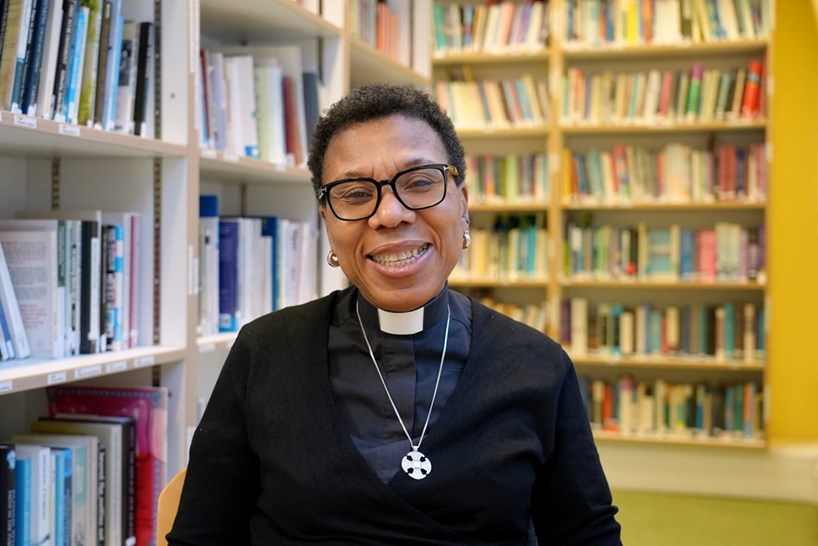 diocese of SouthwarkDr Rosemary Mallett
diocese of SouthwarkDr Rosemary Mallett
Dr Mallett knew of Ogarra Dixon, 24, through his brother, who was involved in football outreach linked to the church. Ogarra was shot dead in the early hours of 17 June 2015 by someone who “was, from what I understand, a friend”, Dr Mallett says. She remembers hearing the sirens that night. Although several families on the estate had lost sons to violent crime, this was “completely unexpected” for the community, because “both families lived in the community.” Shaden Cadette, who was 23, was charged with the murder ten days later, and would be sentenced to at least 27 years.
Dr Mallett opened the church for prayer, and visited Ogarra’s father. “There’s always the potential for retaliatory violence . . . [but] Ogarra’s father had said he wanted no retaliation,” she says.
She was concerned that the funeral that she was planning should not vilify anyone or lead to more violence, and she struck a balance, she says, by having built relationships with the community and the police. “I was seen very much as a trusted member of the community who could rise above the situation. . . I didn’t pass judgement.”
The media, she says, can be “quite invasive” in their search for the story. She and other community leaders spent time with an Evening Standard reporter who had arrived on the estate hours before Ogarra’s murder, to write about conditions there. That paid off: the paper set up a fund that helped to develop projects in the community, which “helped young people find different outlets for their boredom, frustration, anger at their circumstances”.
Her advice to other church leaders is that the church should be visible and empathetic. “These things come out of the blue,” she says, but it’s “important to build up relationships with young people, their families, and community leaders before and after”, so that the church is seen as engaged and compassionate. She would attend a funeral that was not held in her church.
Visit relatives quickly, and let them know that the church “is available for a vigil or for any supportive activity, and, if they don’t want to come into church, then the church can come to them”, she says. She and other church and faith leaders met in the church to discuss ways to support families bereaved by violent crime, and carried out “Walks for peace” — “to show the Church can come out of its walls”, she says.
Finally, she says, recognise that “trauma fans out into the family, and then into the wider community.” So “get to some grips with an understanding of how to respond to trauma.” St John’s put together bereavement materials for families who had lost young people to violence, and the dioceses of Southwark and London have created The Pietà Prayer Resource to respond to incidents of serious youth violence which affect their secondary schools.
Wendy Brownbridge: the flooding of Fishlake
WHEN a month’s rain fell in a day over parts of Yorkshire and the Midlands, nearly every home in the village of Fishlake was flooded. “The place that wasn’t flooded was the church, and a little area around it that included the pub, and a café, and a few houses,” a churchwarden, Wendy Brownbridge, recalls. St Cuthbert’s, Fishlake, had been without a vicar for “six or seven years”, and, on the evening of Friday 8 November 2019, she opened the church for residents and emergency services personnel. (The church had no hall, and the village hall was initially under water.)
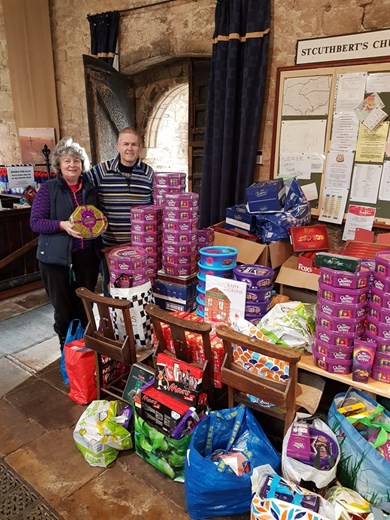 Wendy Brownbridge Help for Fishlake came from as far afield as Cornwall, a school in Germany, and a village in Wales, from where a man drove up, his car so full of chocolates that “the only space left in it was his seat to drive in,” Wendy Brownbridge remembers. The church distributed the chocolates and other treats to each household in the village with a note saying “With love at Christmas from St Cuthbert’s”
Wendy Brownbridge Help for Fishlake came from as far afield as Cornwall, a school in Germany, and a village in Wales, from where a man drove up, his car so full of chocolates that “the only space left in it was his seat to drive in,” Wendy Brownbridge remembers. The church distributed the chocolates and other treats to each household in the village with a note saying “With love at Christmas from St Cuthbert’s”
The next day, her fellow churchwarden, Peter Pridham, set about contacting the media. Mrs Brownbridge meanwhile received the aid that began arriving and soon filled the medieval nave: food, clothing, wellington boots, bedding, cleaning products. It came from the next village, then from other churches, other villages, and supermarkets, businesses, dairies, farmers, chemists, and, in time, from as far afield as Cornwall, Wales, and a school in Germany.
A Billy Graham Rapid Response Team and a retired priest offered chaplaincy support for several weeks. A Muslim charity brought meals 80 miles from Bolton; Sikh groups brought supplies from Birmingham, Doncaster, and elsewhere. For four months, the church was open at least 12 hours a day for emergency services personnel, volunteers, and anyone in need. Mrs Brownbridge, Mr Pridham, and his wife, Ruth, co-ordinated supplies, aided by members of the PCC and the community.
The Prime Minister at the time, Boris Johnson, visited the village. When Prince Charles (as he then was) came before Christmas, the church bought a new doormat. Lockdown brought the 12-hour shifts to an end. Then, Mrs Brownbridge laughs, “I spent two weeks sewing. I just wanted to do nothing.”
What advice would she pass on? Use your churchand draw up a rota: “people don’t need to feel guilty if they can’t be there all the time.”
Get to know the community and your council. “They have funding and the infrastructure to deal with this. . . Know where your vulnerable people are” so you can ensure that rescuers reach them.
Collect details of people who need help, and those offering it, she says, including supermarkets.
Mrs Brownbridge used the media training that she had had in her job: two years earlier, she had retired as deputy director for public health at NHS North Lincolnshire.
Where possible, carry on as normal, she says. With the nave piled high, Mrs Brownbridge, who was also a worship leader in the diocese of Sheffield, led services for the congregation of about 15 in the chancel. The Christmas market and Christmas concert also went ahead.
The stretched churchwardens could provide only limited pastoral support, however, and she feels that the Church missed an opportunity. The Bishop of Sheffield, Dr Pete Wilcox, “was brilliant”, phoning the day after the flooding and visiting in early December, she says; and she appreciated the weeks that the Billy Graham team stayed. The Rural Dean and Archdeacon phoned, but did not visit.
Some people were “distraught . . . seeing their whole lives being washed away. My plea is that there is some mechanism that when these things happen, designated ministers can provide for areas where there are problems, especially if there’s no vicar.”
Alan Everett: Grenfell Tower fire
THE fire that consumed Grenfell Tower, in west London, in the early hours of 14 June 2017, was Britain’s worst residential fire since the Blitz. Seventy-two of the block’s residents were killed, and concerns were raised immediately about how such a high death toll was possible.
The Revd Dr Alan Everett was the Vicar of St Clement’s, Notting Dale. Another local Anglican priest knocked on his door just before 3 a.m., and, after looking in vain for an evacuation centre, Dr Everett unlocked St Clement’s on the way. They returned to find volunteers bringing in water; and breakfast items followed. Young Muslims from east London arrived with blankets and clothing. A church member created a play area using her children’s toys. By 4.30 a.m., about 70 residents and 15 volunteers had gathered.
St Clement’s became a hub for donations, meals, and emergency-services personnel. Staff from two charities based at the church helped to co-ordinate support for the distressed and the bereaved.
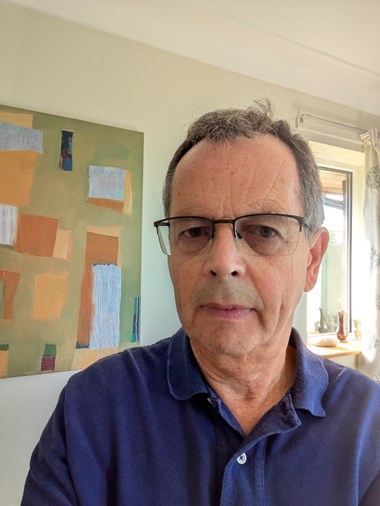 The Revd Dr Alan Everett
The Revd Dr Alan Everett
Someone rang Dr Everett and asked, “Would you speak to Victoria Derbyshire?” (of BBC Television). “I didn’t realise I was actually on air,” he laughs. “I appealed for donations,” but “much” of what arrived was “of no use”.
The Prime Ministera the time, Theresa May; the Labour leader, Jeremy Corbyn; and Archbishop Welby all visited. Baroness May held a follow-up 90-minute meeting at Downing Street with residents and others, including Dr Everett.
Dr Everett soon began planning for the anniversary, including a mass and a garden in the church grounds “for peace and healing”. The garden was dedicated by the Bishop of London, the Rt Revd Sarah Mullally, in the presence of the Mayor of London, Sadiq Khan. Baroness May attended a prayer meeting the next day, and met survivors.
On the actual anniversary, Dr Everett opened the church for a 24-hour vigil, at which NHS support was available for anyone suffering PTSD flashbacks. At 1.30 a.m., he read out the names of the 72 victims. “I came into a church that was completely quiet, and it was completely full,” he recalls.
As for advice to clergy, “dioceses ought to periodically have training for disasters, and work with councils and emergency services on major incident plans,” he says.
Cultivate ecumenical and interfaith relationships, he says. The local faith leaders supported one another and collaborated on a service in St Paul’s Cathedral, six months after the fire. He also valued receiving a blessing during a Roman Catholic mass near by from a bishop of archdiocese of Westminster.
He emphasises that bishops should mainly assume a supportive role rather than a media-focused one, keeping in close communication with local clergy. “It is easy to underestimate how overwhelmed somebody feels on the ground, and how important it is for them to feel they’re part of an organised, supportive response,” he says. Bishops can concentrate on high-profile interventions.
The Area Bishop of Kensington at the time was Dr Graham Tomlin, who facilitated the first meeting with Theresa May at St Clement’s and preached at St Paul’s. Bishop Mullally’s presence on the first anniversary underlined the gravity of the occasion.
Dr Everett would advise caution before appealing for donations on television.
He emphasises the need for support and an outlet for trauma. The diocese of London paid for him to have eight weeks’ counselling immediately after the fire, and he reflected on his experiences in a poem published in The Guardian, and a book, After the Fire: Finding words for Grenfell (Canterbury Press, 2018). He continues to write, and paints.
Finally, he says, know that it’s all right to leave. Dr Everett left two years later; the charred tower still looms over the community, and no charges have been brought over the safety failings. Leaving “came with a sense of guilt about leaving people behind”, he says, “but it was the right thing for me and for my wife and two daughters.”
Key things to consider when the unthinkable happens:
- The need for good relationships with local authorities, emergency services, charities, the community, and other faith or ecumenical leaders.
- What major-incident planning can be drawn on? Materials exist on how to respond to disasters affecting church buildings, and the Living Ministry surveys have explored some challenges affecting clergy well-being.
- Managing the needs that can be met by making a building available for relief efforts and for visible community support, including offering space for lament, and therapeutic, creative forms of remembrance.
- The expectations of senior clergy and dioceses, who have a fine line to tread in needing to be supportive but not get in the way, and could be proactive in providing pastoral support rather than leaving it to ad hoc retired clergy or external groups.
- How to respond to media requests, balancing a community’s need for privacy, and journalists’ need to tell a story.
- Longer-term self-care. Prepare to be profoundly affected, and seek out support, recognition, and space to process experiences as needed.
Wounded Shepherds (SCM Press) and Out of the Depths (Canterbury Press) by Will van der Hart and others will be published in 2026.
The Pietà Prayer Resource created by the dioceses of Southwark and London can be found at: london.anglican.org

